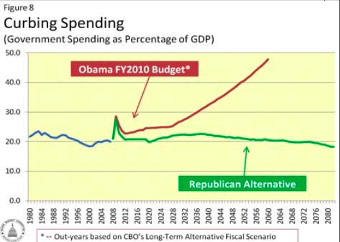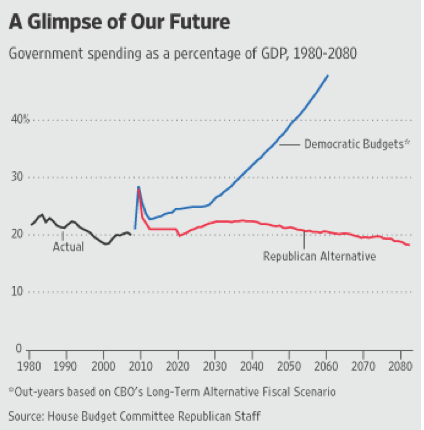Well, having been deservedly mocked last week when they brought out their budget (you remember, the one that had no numbers?), the GOP tried again today.
To their credit, it has numbers this time.
But not surprisingly, it has the tired old GOP plan. This time it is 62 pages long (pdf).
Once again, their idea is to make the Bush tax cuts permanent. But that's just a start.
Tax cuts for the wealthy? Sure, it's in there. Of course, everyone gets tax cuts under the GOP plan. In fact, there's only two tax brackets — a 10% bracket for individuals making under $50,000 (families under $100,000) and a 25% bracket for everyone else (the top income tax bracket right now is 36%). Corporate tax rates also drop to 25%.
Oh, and capital gains cuts. Because the average American is getting killed by taxes on their cappital gains (NOT!)
To balance the lack of income, Republicans intend to stop spending. Well, to freeze spending across-the-board (except, of course, for the Pentagon, because this is the GOP plan) for five years.
And things like Social Security? Well, they basically say that it will dry up in 2041, so we should lower payouts starting in….. 2036. Lower payouts by 0.25% per year…. starting oonly five years before it's dry? And that will buy us, what? One or two more years before Social Security is totally gone? That's a plan?
Later on, the GOP plan acknowledges that their social secuirty solution is just the beginning of a "process" which will eventually "move toward a consensus for saving and strengthening Social Security". In other words, their plan to save Social Security is to… hope that someone comes up with a plan someday.
And Medicare? The GOP answer is to privatize it. In other words, make it go away (since we already have things that assist with medical cost payments — they're called insurance companies).
Perhaps the most amusing feature of the budget is the scoring. Yup, they've gone and figured out the long-term effects of their plan for the next 70 years.
Wow. Well, obviously, the Republican alternative is the way to go. I mean, it's a graph, for crying out loud, that takes into account all the ideological positions of every future Democrat and Republican elected official.
Seriously, though… how were they able to draw those lines? How, for example, would one explain that tiny little dip and bump on the Republican line around 2044/2045? I mean, is that a real dip/bump, or did the graph drawer have a shaky hand?
UPDATE: Actually, this deficit projection is funnier when you realize two things: (a) the GOP plan lowers the top tax rate from 35% to 25%, but allows taxpayers the option to pay the 35% rate if they want to (if not, it's 25%) and (b) the deficit projections in the graph above assume that higher income people — all of them — will choose to voluntarily pay the higher tax rate.
UPDATE: Oh, this is rich. You see that ominous looking blue line going up up up on the graph below? Turns out that the GOP projections aren't based on the Obama budget at all. The Congressonal Budget Office (CBO) never ran a "Long-Term Alternative Fiscal Scenario" on the Obama budget. That ominous blue line represents the long-term alternative fiscal scenario that the CBO worked out eight months ago – on Bush's budget!
UPDATE: And then there's this gem:
* Energy. Our budget lays a firm foundation to position the U.S. to meet three important strategic energy goals: reducing U.S. dependence on foreign oil, deploying more clean and renewable energy sources free of greenhouse gas, and supporting economic growth. We do these things by rejecting the president's cap-and-trade scheme, by opening exploration on our nation's oil and gas fields, and by investing the proceeds in a new clean energy trust fund, infrastructure and further deficit reduction.
If you bother to unpack that, what they're proposing is to fund new clean energy by (1) doing such things as off-shore drilling and (b) using money that we save by permitting factories to pour CO2 into the air.


